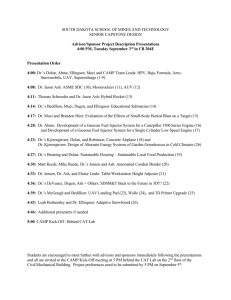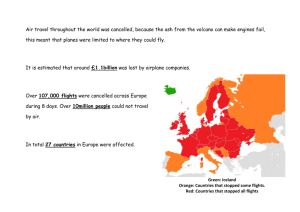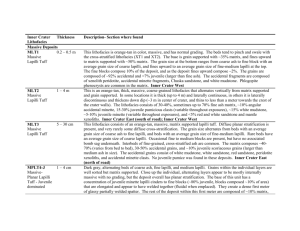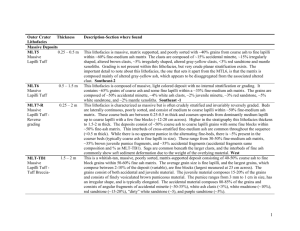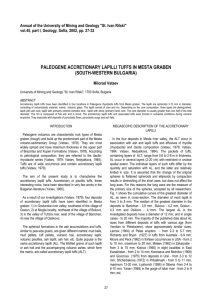Appendix 1 Methods Terminology The nomenclature for bed
advertisement
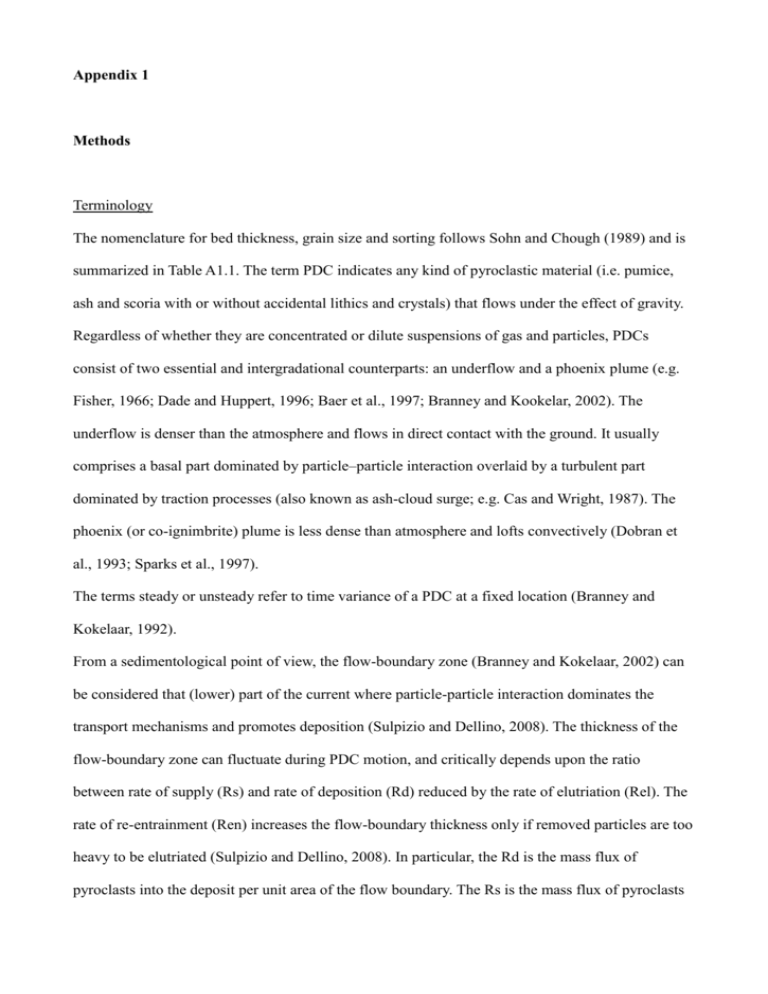
Appendix 1 Methods Terminology The nomenclature for bed thickness, grain size and sorting follows Sohn and Chough (1989) and is summarized in Table A1.1. The term PDC indicates any kind of pyroclastic material (i.e. pumice, ash and scoria with or without accidental lithics and crystals) that flows under the effect of gravity. Regardless of whether they are concentrated or dilute suspensions of gas and particles, PDCs consist of two essential and intergradational counterparts: an underflow and a phoenix plume (e.g. Fisher, 1966; Dade and Huppert, 1996; Baer et al., 1997; Branney and Kookelar, 2002). The underflow is denser than the atmosphere and flows in direct contact with the ground. It usually comprises a basal part dominated by particle–particle interaction overlaid by a turbulent part dominated by traction processes (also known as ash-cloud surge; e.g. Cas and Wright, 1987). The phoenix (or co-ignimbrite) plume is less dense than atmosphere and lofts convectively (Dobran et al., 1993; Sparks et al., 1997). The terms steady or unsteady refer to time variance of a PDC at a fixed location (Branney and Kokelaar, 1992). From a sedimentological point of view, the flow-boundary zone (Branney and Kokelaar, 2002) can be considered that (lower) part of the current where particle-particle interaction dominates the transport mechanisms and promotes deposition (Sulpizio and Dellino, 2008). The thickness of the flow-boundary zone can fluctuate during PDC motion, and critically depends upon the ratio between rate of supply (Rs) and rate of deposition (Rd) reduced by the rate of elutriation (Rel). The rate of re-entrainment (Ren) increases the flow-boundary thickness only if removed particles are too heavy to be elutriated (Sulpizio and Dellino, 2008). In particular, the Rd is the mass flux of pyroclasts into the deposit per unit area of the flow boundary. The Rs is the mass flux of pyroclasts per unit area supplied to the lowermost concentrated part of the current (Branney and Kokelaar, 2002). The term Eruptive Unit is used sensu Fisher and Schmincke (1984), and indicates deposits emplaced during a certain time lapse within the eruption and that represent a distinct composition or episode of eruptive dynamics within an eruptive phase. An EU can contain sub-units, which represent different episodes of deposition recognisable within an EU. The term pulse indicates part of a deposit emplaced from an unsteady, pulsating current. A pulse is generally self-organised and develops an independent flow-boundary zone (Sulpizio and Dellino, 2008). The term bedding surface indicates a generally planar surface within a deposit picked out by a sharp change in grain size or grain type (Branney and Kokelaar, 2002). Grain size and componentry More than 65 samples were collected in order to study the vertical and lateral variations of both grain size and componentry of the EU5 products. After drying, samples were mechanically sieved from -6 and +4 (64 to 0.063 mm; =-log2 mm), at 0.5 intervals. To avoid artificial breaking of the largest pumice fragments, the coarser grain sizes (-6 to -2.5 ) were sieved using gentle hand shaking. The finer fractions (-2.0 ÷ +4.5 ) were analysed using a sieving machine. Grain size parameters were calculated using the GRADISTAT programme (Blott and Pye, 2001). Selected analysed samples were split into three main lithologies (juvenile, loose crystals and accessory lithic fragments) by hand picking (fractions between -6 and 0 ) and counting points under a binocular microscope. Then the loose crystal population was separated into salic and femic components, while the juvenile population was separated into vesicular and dense fragments (Table A1.2). Lithofacies analyses Lithofacies analysis is a common tool in sedimentological studies in marine, fluvial and alluvial fan environments (e.g. Miall, 1978; 1985; Lowe, 1982; Mathisen and Vondra, 1983; Smith, 1986; 1987; Waresback and Turbeville, 1990; Zanchetta et al., 2004a), but in recent years it has been largely applied to the study of complex sequences of pyroclastic deposits (Sohn and Cough, 1989; Cough and Sohn, 1990; Colella and Hiscott, 1997; Gurioli et al., 2002; Sulpizio et al., 2007; 2008b). The different lithofacies of the PdA PDC deposits have been defined using texture, sedimentary structures, grain size and sorting. The first letters of lithofacies identifiers indicate the general appearance of the deposit (m=massive, ds=diffusely stratified, xs=cross-stratified, lens=lenticular, align=alignments of lithics and/or pumice), the capital letters indicate the grain size (A=ash, L=lapilli, B=blocks), and the subscripts the general gradation of the deposits. As a whole, three main lithofacies categories were identified: massive, stratified and lenticular (Table A1.3). These three main categories contain a number of lithofacies, in some cases peculiar to a certain EU or subEU. Each lithofacies is described in detail, and the inferred sedimentary processes discussed (Table A1.3). Table A1.1 - Nomenclature used in the text for bed thickness, grain size and sorting of the pyroclastic deposits (from Sohn and Chough, 1989). Dist. F. ash km (wt%) C. ash Lapilli (wt%) (wt%) Md Sk M1 M2 AVL3 AVL2 AVL2 AVL2 AVL6 AVL6 AVL1 AVL1 AVL1 AVL1 AVL1 AVL1 AVL4 AVL4 AVL4 AVL5 AVL5 AVL5 AVL7 AVL7 AVL7 2.8 4.5 4.5 4.5 8 8 10 10 10 10 10 10 10.5 10.5 10.5 10.5 10.5 10.5 11 11 11 2,03 40,09 0,56 21,56 56,05 49,69 42,88 31,57 40,23 37,90 5,10 20,05 50,33 12,97 53,90 55,63 11,50 39,15 24,12 12,31 37,97 23,42 59,35 11,68 66,50 43,95 50,31 57,08 68,44 59,71 61,63 94,90 79,96 49,67 87,03 46,10 44,37 88,50 60,85 75,71 87,69 62,03 74,55 0,56 87,76 11,94 0,00 0,00 0,00 0,00 0,00 0,50 0,00 0,00 0,00 0,00 0,00 0,00 0,00 0,00 0,18 0,00 0,00 -2,33 3,73 -1,93 1,48 4,11 4,00 3,84 3,50 3,55 3,63 0,45 3,35 4,00 0,50 4,03 4,07 0,69 3,50 2,54 0,96 3,52 1,83 1,31 0,16 2,55 1,12 1,03 1,43 1,01 1,47 0,91 1,05 1,34 1,18 1,78 1,05 1,02 1,65 2,20 1,91 1,45 1,32 0,19 -0,16 -0,02 0,11 -0,14 -0,02 -0,28 0,01 -0,04 0,02 0,45 -0,13 -0,09 0,69 -0,07 -0,12 0,64 -0,25 -0,02 0,68 -0,06 -2,74 3,24 -1,74 -0,26 3,24 3,24 3,24 3,24 3,24 3,24 0,21 3,24 3,24 0,21 3,24 4,72 0,75 0,75 0,75 0,75 3,24 EU5b AVL3-2 AVL3-3 AVL3-4 AVL3-5 AVL3-6 AVL3-7 AVL3-8 AVL3-9 AVL2-4 AVL2-5 AVL2-6 AVL2-7 AVL2-8 AVL2-9 AVL6-1 AVL6-2 AVL1-7 AVL1-8 AVL1-9 AVL1-10 AVL4-4 AVL4-3 AVL5-4 AVL5-5 AVL7-3 AVL7-4 AVL7-7 AVL3 AVL3 AVL3 AVL3 AVL3 AVL3 AVL3 AVL3 AVL2 AVL2 AVL2 AVL2 AVL2 AVL2 AVL6 AVL6 AVL1 AVL1 AVL1 AVL1 AVL4 AVL4 AVL5 AVL5 AVL7 AVL7 AVL7 2.8 2.8 2.8 2.8 2.8 2.8 2.8 2.8 4.5 4.5 4.5 4.5 4.5 4.5 8 8 10 10 10 10 10.5 10.5 10.5 10.5 11 11 11 1,24 12,39 10,44 3,29 34,15 10,93 10,85 53,54 0,72 1,64 1,02 4,94 9,47 66,04 8,11 52,49 3,25 1,89 1,95 40,43 13,61 60,72 11,32 55,54 3,83 51,28 46,94 32,26 50,60 60,48 83,08 58,90 66,75 68,63 42,90 53,73 33,15 66,88 82,67 74,03 33,34 91,89 47,51 72,21 59,20 65,51 58,29 84,91 39,28 88,12 44,46 93,04 48,76 53,02 66,49 37,01 29,07 13,64 6,96 22,32 20,52 3,56 45,56 65,21 32,10 12,39 16,50 0,62 0,00 0,00 24,54 38,91 32,55 1,26 1,49 0,00 0,55 0,00 3,14 0,00 0,00 -1,60 0,01 0,50 0,11 3,15 0,80 0,52 4,04 -0,96 -1,45 -0,52 -0,01 0,24 4,50 0,45 4,01 -0,52 -0,86 -0,57 3,64 0,46 4,30 0,85 4,07 4,03 3,89 1,49 3,11 2,68 1,21 2,56 2,47 2,39 2,14 0,98 1,09 0,97 0,95 1,84 1,26 0,96 1,01 0,73 0,73 0,82 1,33 1,97 1,07 1,55 1,07 0,64 1,20 2,89 0,08 0,14 0,06 0,24 0,00 0,08 0,16 -0,44 0,03 0,12 0,03 0,35 0,36 -0,36 0,55 -0,01 0,29 0,12 -0,02 -0,15 0,65 -0,16 0,61 -0,10 0,43 -0,09 -0,38 EU5c AVL3-10 AVL3-11 AVL3-12 AVL3-13 AVL2-10 AVL2-11 AVL1-11 AVL1-12 AVL1-13 AVL4-2 AVL4-1 AVL5-6 AVL5-7 AVL7-5 AVL7-6 AVL7-8 AVL7-9 AVL7-10 AVL7-11 AVL7-12 AVL3 AVL3 AVL3 AVL3 AVL2 AVL2 AVL1 AVL1 AVL1 AVL4 AVL4 AVL5 AVL5 AVL7 AVL7 AVL7 AVL7 AVL7 AVL7 AVL7 2.8 2.8 2.8 2.8 4.5 4.5 10 10 10 10.5 10.5 10.5 10.5 11 11 11 11 11 11 11 21,47 1,89 2,19 41,57 4,15 48,94 3,28 26,11 6,70 50,32 64,39 35,78 34,85 19,38 30,35 44,77 20,55 50,48 9,12 32,25 61,71 55,24 68,73 57,96 42,62 45,06 96,72 73,89 66,04 48,65 35,61 64,22 65,15 76,30 69,64 55,23 63,35 49,52 63,03 67,70 16,83 42,88 29,08 0,47 53,23 3,02 0,00 0,00 27,26 1,03 0,00 0,00 0,00 4,31 0,00 0,00 16,11 0,00 27,86 0,00 1,53 -0,65 -0,05 3,54 -1,06 4,00 0,99 2,94 -0,26 4,00 4,41 3,45 3,09 0,98 2,00 3,83 0,99 4,00 0,01 3,00 2,74 2,05 1,78 1,77 1,83 2,20 0,77 1,68 1,35 2,42 0,97 1,94 2,01 2,28 2,15 1,71 2,67 2,05 2,16 2,06 -0,02 -0,04 0,02 -0,11 0,15 -0,41 0,16 0,00 0,23 -0,43 -0,04 -0,09 -0,07 0,43 0,29 -0,21 0,22 -0,40 0,18 -0,09 Sample EU5a AVL3-1 AVL2-1 AVL2-2 AVL2-3 AVL6-4 AVL6-3 AVL1-1 AVL1-2 AVL1-3 AVL1-4 AVL1-5 AVL1-6 AVL4-7 AVL4-6 AVL4-5 AVL5-1 AVL5-2 AVL5-3 AVL7-0 AVL7-1 AVL7-2 Sect. F1 F2 (wt%) (wt%) Md vj vj Md dj dj Md l l Md sc sc Md fc -1,24 -5,74 4,72 1,76 3,24 4,72 4,72 4,25 4,25 0,21 4,72 1,76 2,23 4,72 1,76 4,25 3,24 1,76 4,72 3,24 3,24 1,76 4,25 0,75 13,81 97,33 2,89 69,73 97,77 100,00 99,96 99,65 99,18 97,52 82,77 98,80 100,00 82,98 100,00 100,00 92,77 98,18 96,66 98,59 100,00 2,03 40,09 0,56 21,56 56,05 49,69 42,88 31,57 40,23 37,90 5,10 20,05 50,33 12,97 53,90 55,63 11,50 39,15 24,12 12,31 37,97 -2,26 -1,46 0,49 0,95 0,76 2,24 1,85 - 1,94 1,07 1,86 1,82 0,37 0,85 1,89 - -2,48 -1,53 0,05 0,48 0,57 0,61 0,75 1,00 0,96 - 2,06 0,93 1,05 0,50 1,88 1,65 0,77 0,74 1,39 - -2,50 -1,99 -0,17 0,47 0,40 0,52 0,67 0,81 0,84 - 1,60 0,78 1,41 0,45 0,49 0,64 0,67 0,65 1,01 - 1,00 -0,98 0,81 0,64 0,73 0,95 0,90 1,25 1,01 - 2,10 1,70 1,18 1,69 2,11 1,90 0,76 0,91 1,66 - 1,71 -0,54 1,26 0,50 0,99 1,17 0,98 1,37 1,49 - 2,49 1,45 1,14 0,84 2,00 1,64 0,66 0,66 1,78 - 2,0 0,3 0,7 1,7 2,2 3,1 1,6 - 7,4 7,3 11,3 16,1 16,6 20,8 9,1 8,4 22,0 - 82,9 87,4 37,8 52,3 53,2 49,2 18,4 29,5 40,2 - 4,9 2,7 6,2 21,0 19,7 19,9 6,1 6,7 23,5 - 2,9 2,4 5,3 9,9 8,8 7,9 3,3 4,9 12,7 - 100,0 100,0 60,6 100,0 100,0 100,0 40,0 49,5 100,0 - -1,24 -1,24 -0,26 -0,26 3,24 -0,26 -0,26 4,72 -1,24 -1,24 -0,26 -0,26 -0,26 4,72 0,21 3,24 -0,26 -0,73 -0,26 3,24 0,21 4,72 0,75 4,72 -0,26 3,24 4,72 -2,24 -0,26 3,24 1,76 0,75 4,72 -0,73 1,76 0,75 0,75 1,76 3,24 -0,26 0,75 3,24 0,75 4,25 4,72 3,24 3,24 0,75 4,72 -0,26 0,75 14,74 50,71 56,51 55,71 82,19 62,60 60,81 90,11 18,54 11,72 26,86 46,92 57,15 96,41 77,03 100,00 20,24 15,40 19,98 96,59 72,15 99,63 93,25 100,00 49,20 100,00 88,94 1,24 12,39 10,44 3,29 34,15 10,93 10,85 53,54 0,72 1,64 1,02 4,94 9,47 66,04 8,11 52,49 3,25 1,89 1,95 40,43 13,61 60,72 11,32 55,54 3,83 51,28 46,94 -0,96 0,38 -1,00 1,14 1,75 2,43 3,01 -1,40 -0,53 0,48 0,43 1,00 -1,30 0,41 0,66 0,08 - 1,39 2,97 2,50 0,67 0,58 1,54 1,99 1,36 1,29 1,49 1,93 1,81 1,29 2,11 1,62 0,63 - -1,86 0,76 1,00 0,50 1,48 1,28 1,02 -0,84 -0,97 -0,37 -0,03 0,57 0,48 -0,69 -0,55 -1,00 0,50 0,93 -0,02 - 1,57 3,09 2,59 1,25 1,33 2,73 2,07 1,26 1,04 0,83 1,24 2,20 1,53 0,84 0,81 0,77 2,06 1,72 0,51 - -1,95 -0,82 -0,28 -0,10 0,22 0,12 -0,12 -1,00 -1,51 -0,85 -0,22 -0,34 0,25 -0,60 -0,99 -0,70 0,12 0,63 -0,10 - 1,32 2,79 2,47 0,82 1,46 1,99 0,83 0,90 0,96 0,92 0,73 1,12 0,56 0,60 0,45 0,80 0,72 0,58 0,55 - 0,48 3,03 2,58 1,05 1,96 2,97 3,05 -0,03 -0,11 0,06 0,63 1,21 0,67 -0,04 -0,37 0,00 1,59 1,00 0,21 - 1,53 1,89 1,69 0,96 1,01 1,68 1,81 0,9 1,86 0,86 1,88 2,17 1,97 1,48 0,95 1,78 2,33 1,88 1,11 - 0,43 2,63 2,00 1,00 1,78 2,42 1,69 -0,22 -0,50 0,11 0,81 1,00 0,98 0,05 0,00 0,36 0,64 1,32 0,49 - 1,25 2,09 1,91 1,67 1,00 1,85 1,71 1,03 1,51 0,73 1,77 1,89 1,95 1,41 0,97 0,79 1,53 1,76 0,92 - 1,3 1,0 0,8 1,2 0,3 0,6 1,3 0,4 0,9 1,1 1,7 0,8 1,2 1,3 1,9 1,9 1,7 1,0 - 10,0 12,0 12,0 13,9 7,0 18,9 16,8 11,7 12,3 13,7 25,9 19,5 17,1 16,2 11,1 11,1 17,8 24,6 15,5 - 79,2 68,9 68,1 63,5 30,6 60,7 60,1 77,9 75,9 68,9 54,7 54,8 58,3 67,1 70,5 75,1 52,2 48,1 53,7 - 5,8 12,9 13,8 16,2 4,8 14,7 14,9 6,1 6,5 9,6 12,0 16,5 14,5 10,3 11,4 8,3 19,7 17,3 21,4 - 3,6 5,2 5,3 5,2 1,7 5,0 6,9 3,9 4,4 6,5 5,7 8,3 8,7 6,4 5,5 3,6 8,5 8,1 8,4 - 100,0 100,0 100,0 100,0 44,4 99,9 100,0 100,0 100,0 99,9 100,0 100,0 99,9 100,0 99,9 99,9 100,0 99,9 100,0 - 3,24 -0,26 -0,26 3,24 -1,24 4,72 0,75 3,24 -0,26 4,72 4,72 1,76 1,29 -0,26 0,75 4,72 -0,26 4,72 -0,26 4,72 1,76 -0,26 -1,24 1,76 0,75 1,76 4,72 1,76 -0,26 -2,74 3,24 0,75 1,76 -0,26 3,24 4,25 4,72 3,24 3,24 4,25 4,72 1,76 0,75 4,72 1,76 -0,26 4,72 3,24 0,75 3,24 71,53 35,33 46,95 98,25 25,60 90,65 90,42 98,63 42,10 90,58 99,86 100,00 100,00 74,71 94,68 99,21 66,18 94,25 51,32 94,49 21,47 1,89 2,19 41,57 4,15 48,94 3,28 26,11 6,70 50,32 64,39 35,78 34,85 19,38 30,35 44,77 20,55 50,48 9,12 32,25 0,90 0,96 0,51 -0,99 1,18 -0,54 0,37 1,28 1,36 0,06 1,01 0,03 - 1,89 1,99 1,11 1,67 0,70 1,72 1,08 0,67 0,76 0,98 1,06 1,80 - 0,83 -0,44 0,07 0,00 1,03 3,04 0,44 0,72 1,52 1,25 0,17 1,06 -0,46 0,18 - 1,62 2,64 2,35 2,79 0,70 1,48 2,57 1,12 0,71 0,66 0,98 0,90 1,88 2,88 - -0,31 -1,00 -0,55 -1,58 0,63 2,46 -0,60 0,20 1,49 1,04 -0,13 0,85 -0,22 -0,48 - 1,6 1,62 1,45 1,41 0,68 1,63 1,11 0,87 0,70 0,64 0,70 0,81 1,36 1,51 - 1,7 1,54 1,35 0,93 1,03 3,31 0,51 0,92 1,75 1,43 0,90 0,92 0,97 1,04 - 0,98 1,47 1,36 2,26 0,69 1,36 2,06 1,05 0,71 0,67 1,03 0,87 1,17 2,19 - 1,63 1,44 1,45 0,49 1,47 3,01 1,00 0,93 1,66 1,35 0,54 1,03 0,45 0,86 - 1,13 1,55 1,41 1,38 0,69 1,43 2,09 0,89 0,62 0,67 0,92 0,83 1,08 1,82 - 1,0 1,5 1,6 1,1 0,5 1,8 0,5 0,4 0,5 1,2 1,1 1,5 - 9,7 16,1 22,2 14,2 17,5 23,2 10,9 5,4 11,0 9,5 12,3 14,7 13,8 17,3 - 41,8 69,5 56,5 68,9 44,5 29,0 65,6 16,4 19,0 21,9 26,3 23,7 36,6 55,6 - 7,3 7,8 12,7 9,9 27,1 37,2 15,2 6,4 9,3 11,0 18,7 12,0 12,2 17,5 - 4,8 5,1 6,9 5,7 10,4 10,6 6,5 3,2 2,8 4,3 8,5 5,6 4,9 8,1 - 64,6 100,0 100,0 99,9 100,0 100,0 100,0 31,9 42,5 47,2 67,0 57,1 67,5 100,0 - M3 fc Ves. J. Dense J. Lith. S. Cryst. F. Cryst. Tot. Anal. (wt%) (wt%) (wt%) (wt%) (wt%) (wt%) Table A1.2 - Grain-size parameters and components of the analysed samples. Md = median diameter, = sorting, Sk = skewness (all calculated following Folk and Ward, 1956). M1 = main mode. M2 = second mode. M3 = third mode. F1 = plot of wt.% finer than 1 mm; F2 = plot of wt.% finer than 1/16 mm (Walker, 1983). Mdvj, dj, l, sc, fc = median diameter of vesicular juvenile, dense juvenile, lithic, salic crystal or femic crystal components, vj, dj, l, sc, fc = sorting of vesicular juvenile, dense juvenile, lithic, salic crystal or femic crystal components. Ves. J. = vesicular juvenile component; Dense J. = dense juvenile component; Lith. = lithic component; S. Cryst. = salic crystal component; F. Cryst. = femic crystal component. Tot. an. = total of the sample analysed for components. Lithofacies code P Paleosols. Massive lithofacies mA, mvA maccrA Massive ash, massive vesicular ash, accretionary lapilli-bearing ash mcA Massive coarse ash mL, mL(il), mLB Massive lapilli, massive lapilli with reverse grading of lithics massive lapilli and blocks mAL, Massive ash and lapilli, isL, isAL Impersistent stratified lapilli, impersistent stratified ash and lapilli Stratified lithofacies dsL, dsAL, dsLA Diffuse-stratified lapilli, diffusestratified ash and lapilli, diffusestratified lapilli and ash sAL+xsA Stratified ash and lapilli plus cross-stratified ash. Description Brown to dark-brown fine sand and silt, sometimes with high clay content. Usually rich in organic matter. Massive texture, sometimes with horizons, rootlets and rhizoconcretions. Interpretation Paleosols with variable degree of maturity Massive fine ash, sometimes with scattered pumice and lithic lapilli. Presence of vesicles (mvA) and accretionary lapilli (maccrA). Thickness ranges between few centimetres and few decimetres, and is rather constant at the scale of the outcrop. Poor sorting Massive coarse ash. Thickness of few cm, almost constant at the scale of the outcrop. Good sorting. Lithofacies mL and mL(il). Massive, fine to coarse lapilli with minor content of ash. Sometimes reverse grading of lithic clasts occurs. Thickness varies from few cm to few dm, and is almost constant at the scale of the outcrop. Moderate to poor sorting. Lithofacies mLB. Massive pumice and lithic lapilli with outsized blocks. Thickness from few dm to about 1 m. Medium to poor sorting Massive ash with sparse pumice and lithic lapilli. Decimetre- to metre-thick tabular or lenticular (metres-wide) bodies. Poor sorting. Gentle settling of fine-grained particles from sustained columns or from ash clouds that accompanied pyroclastic density currents. Fallout depositional regime. Generally massive lapilli or ash and lapilli with impersistent stratification usually visible at a certain distance from the exposure. Reverse garding of coarse particles is common. Thicness from few dm to few m. Poor sorting. Basal part of PDCs in very distal areas. Tractive to temporarily fallout depositional regime Coarse grained basal underflows of PDCs with flow boundary-zone dominated by granular flow regime. Reverse grading of lithic clasts indicate the effective occurrence of kinetic sieving and kinematic squeezing processes at time of deposition. The general poor sorting and the massive appearance are suggestive of sedimentation from a current in which the rate of supply (Rs) is higher than the rate of deposition (Rd). This induces the rapid development of a zone of high particle concentration above the flow-boundary, dominated by fluid escape or granular flow regimes. The general massive appearance, the poor sorting and the reverse grading of coarse clasts indicate a flow boundary-zone dominated by granular flow regime. Impersistent stratification is due to shear accommodation at time of deposition. The whole granular-dominated pulse stop enmasse due to grain interlocking, but the braking process produced limited differential movements within the depositing mass. This results in minor clast alignments or imbrication that resemble a faint stratification. Diffuse-stratified pumice and lithic lapilli (dsL) with scarce (dsLA) to abundant (dsAL) ash matrix. Sometimes the largest elongated clasts exhibit a major axis which is transverse to the flow direction. Individual bedding surfaces are persistent over a few decimetres to some metres before fading. Thickness of individual bedding surfaces ranges between a few centimetres to a few decimetres. Poor sorting. The diffuse stratification due to the bedding of lapilli indicates a flow-boundary with transitional depositional regime, which is influenced by traction processes but also characterised by a high rate of deposition (Rd) Stratified medium to coarse ash and lapilli. The ash shows cross-stratification, while fine lapilli form bedding surfaces and inversely graded lenses. Individual laminae in crossstratified ash are discontinuous over a few The stratification of ash and lapilli and the cross- stratification of the fine to coarse ash indicate grain by grain deposition from a fully diluted, turbulent current with a flowboundary zone dominated by traction Alternating lithofacies altAL, altLA, altcfA Alternating ash and lapilli, alternating lapilli and ash, alternating coarse and fine ash Lenticular lithofacies lensBL, lensL+sA Lens of blocks and lapilli, lens of lapilli plus stratified ash decimetres and truncations are common. Thickness generally in the range of some m. Medium to poor sorting. regime. Alternating beds of ash and lapilli or coarse and fine ash. The ash beds sometimes show stratification, while the clasts in the upper part of the lapilli beds sometimes show imbrication. Thickness of each bed of few cm. The lapilli and the coarse ash beds have good sorting. The alternating beds of lapilli and ash or coarse and fine ash testify for stepwise aggradation of discrete pulses developed within each depositional unit. The general massive appearance of lapilli and coarse ash beds indicate that the flow-boundary zone of each pulse was dominated by granular flow regime. Ash beds testify for sedimentation from the waning stage of each pulse, mainly in the traction to fallout regime. Lenses of blocks and coarse lapilli with minor ash (lensBL) and lenses of lapilli plus stratified ash. Coarse lapilli and blocks usually define normal to reversely-graded lenses. Sometimes lens packages occur, interstratified with crossstratified coarse ash. The thickness of individual lenses ranges between some dm and several m. Lenses show moderate sorting, while interbedded coarse ash has moderate to good sorting. The development of lenses of coarse lapilli and blocks indicates a flow boundary-zone with high concentration of solid particles and dominated by granular flow or fluid escape regimes, which at different times was impinged by large turbulent eddies. Waning phases of the flows developed flow boundary-zones with lower sediment load and dominated by traction regime, which deposited the stratified ash Table A1.3 - Lithofacies scheme used for describing the PDC deposits of the Pomici di Avellino eruption Appendix 2 Method for calculating the physical parameters of PDCs The first step is the calculation of the flow-dynamic characteristics at the base of the shear current, namely flow shear velocity (u)*, density (f) , and shear stress, ( where f u2*); then the flow stratification characteristics are reconstructed. The model first assumes that during the formation of the stratified layer, particles were settled from turbulent suspension when their terminal velocity (w) approached the shear velocity of the current, so w= u*. A particle’s terminal velocity is given by the Newton impact law: where g is acceleration due to gravity, d is the median particle size, s is the particle density and Cd is the particle drag coefficient. The particle drag coefficient is calculated following the method introduced by Dellino et al. (2005) where is the fluid viscosity (in our case, 1.78 x 10-5 Pa s), and is the particle shape factor. Since the two components settled together, it is possible to equate their terminal velocity and solve for the current shear velocity and density by means of the equalities: where the subscript px stands for “pyroxene loose crystals” and juv stands for “vesicular juvenile particles”. Solutions are found on a statistical basis, and results are expressed as the range of 68% probability around the average value, and for the range including the values corresponding to plus and minus one standard deviation (1 ) around the mean in a Gaussian distribution. As for the current stratification characteristics, it should be noted that the lower part of the current, due to the higher particle volumetric concentration, is denser than atmosphere. The upper part is less dense than the atmosphere because particle concentration is low and the high gas temperature renders fluid density lower than that of the atmosphere. The height of the shear current (Hsf) corresponds to the level at which current density equals atmosphere density (atm.). The following equation: allows the calculation of shear current height (Hsf) when the shear stress at the base of the current, (as calculated from the values of shear velocity and density previously obtained) and slope inclination (which is measured in the field) are known. Flow density is linked to particle volumetric concentration (C) by: where g is the gas density (in our case steam at 300° C), and is set at 0.78 kg/m3. The particle volumetric concentration gradient can be calculated with respect to a reference level y0 at which concentration C0 is known, by: where Htot is the total flow thickness. The reference level is assumed to be very close to the ground surface, where particles settle from suspension to form the bedload. The reference concentration is close to maximum particle packing, about 75%. Pn(susp) is a dimensionless group, the Rouse number of the suspension population, which is given by: where k is the Von Karman constant = 0.4. For reconstructing the density profile of the current, equations (4), (5) and (6) are combined and an equation system is implemented: Equation (8) states that atmosphere density atm is reached at the top of the shear current Hsf and equation (9) states that the average density of the shear current refers to the part of the flow between the reference level y0 and the shear current height Hsf. By solving the system of (8) and (9), the Rouse number (Pn(susp)) and reference height (y0) are calculated. With these results, by means of (6) and (5), the particle concentration and the density profiles are obtained. The velocity profile is calculated by the law of the wall for rough turbulent flows: where ks is the ground surface roughness (in our case 5 cm) as measured in the field. Dynamic pressure is also stratified in the current and its gradient is: By means of (11), the density and velocity gradients are combined, and the dynamic pressure profile is reconstructed. With regard to current stratification characteristics, solutions are also found statistically, and stratification profiles may be obtained for the average, maximum and minimum solutions.



